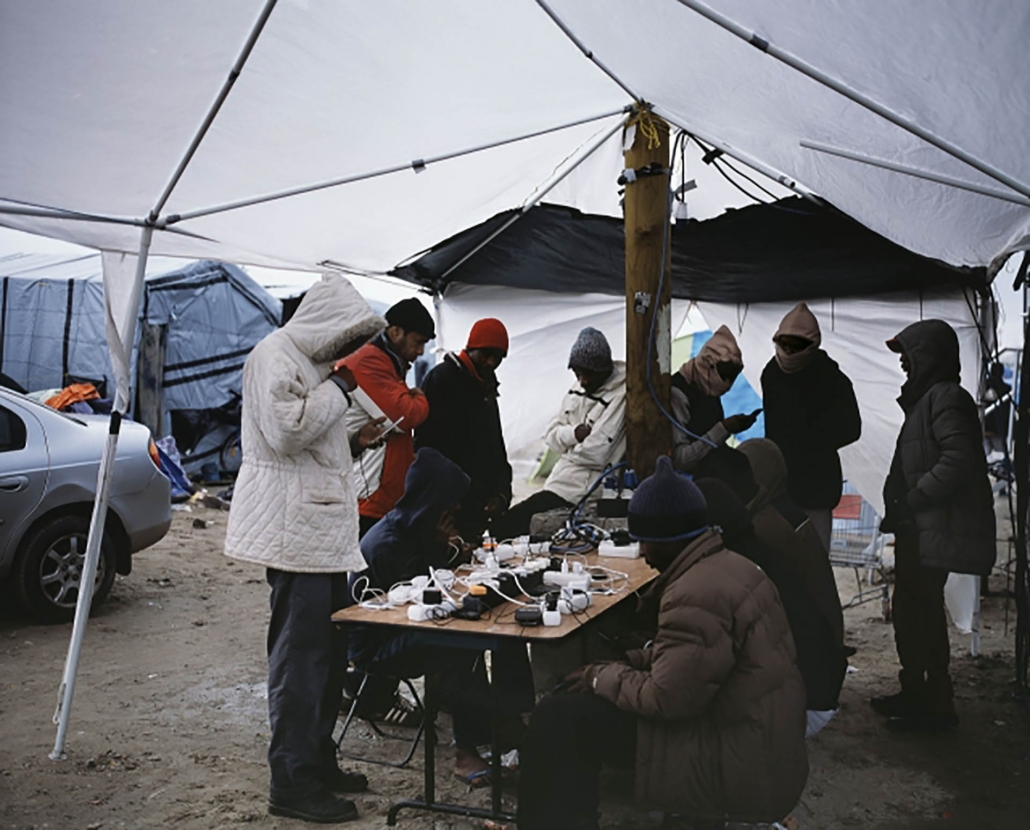This post is also available in:
 French
French
This exhibition is conceived as an experiment and a comparative approach of a contemporary imagery of migration. More specifically, it focuses on the situation of refugees and exiles settled in a camp located on the outskirts of the city of Calais, named the ”Jungle”, before it was dismantled in October 2016. Through three approaches, the exhibition explores the different functions, roles and status of the image: the one of artist Bruno Serralongue and his documentary project Calais (2006-2018), the photographs of Agence France-Presse, diffused by the media, and, finally, the testimonies of the former inhabitants of the ”Jungle”.
In 2002, the closure of the Sangatte camp led to the retreat and installation of migrants hidden in the forests. It is from 2005 that Bruno Serralongue has been following the secret occupation of these places and their metamorphoses. Using a photographic chamber, he captures the different moments of the life of the exiles and their first temporary camps. It documents their attempts to reach England and the installation of the ”state slum” until it was dismantled in 2016. His photographs belong to a slow temporality and are characterized by an offbeat approach whose goal is to establish a distance with the event. Thus, his images offer an alternative to media pictures while being part of a visual tradition and more particularly the one of the history painting.
The print and online publications of photographs and photojournalists of Agence France-Presse provide another example of the role of photography. The office of the media image seems obvious at first sight, it’s mostly focused on events rather than on everyday life since it must inform and draw attention to itself in an environment where grabbing public attention becomes more and more a battle. These images carry a double intention, it is as much about condensing a large amount of information as about being at the initiative of an iconic image escaping the stereotypes specific to the subject. Thus, a dialect installs between the mass of publications which makes important the humanitarian scope and the media presence that sometimes tends to make blind. This section, co-produced with Agence France-Presse, contains interviews with its main figures, including photographer Philippe Huguen, Olivier Morin, photo editor-in-chief for France, and Virginie Grognou, video editorial assistant in chief video who had covered the ”Jungle” as a video reporter, but also with other personalities of the media world like Nicolas Jimenez, photo director of Le Monde.
Finally, the perspectives of refugees, exiles and migrants offer another decoding of the events and living conditions of the inhabitants of the ”Jungle”. The third part of the exhibition is devoted to their testimonies. Their photos and videos show another reality which is contrary to the one presented by the media; they highlight the importance of an existential tool, their mobile phones, which are not only used as a means of communication with their families and a navigation tool on the road but also as a camera. The presented photographs are not only those of amateurs but also of artists and professionals of the image who sometimes became such by the force of things. Among them, there are Shadi Abdulrahman, Riaz Ahmad, Alpha Diagne, Zeeshan Haider, Ali Haghooi, Babak Inanlou and Arash Niroomand.
The end of the exhibition tour provides a new participatory action of Séverine Sajous and Julie Brun who initiated a workshop entitled ”Jungleye” in Calais in 2015. Their new project, supported by Emmaüs-Paris, links Calais and Paris reminding that ”the Jungle of Calais” was nothing but a configuration of a phenomenon wich is still present: exile and migration
From 16/10/2019 to 24/02/2020
CENTRE POMPIDOU (GALERIE DE PHOTOGRAPHIES)
Place Georges-Pompidou
75004 PARIS
France
Opening hours : Every day except Tuesday from 11am to 9pm
Phone : 01 44 78 12 33
presse@centrepompidou.fr
www.centrepompidou.fr



